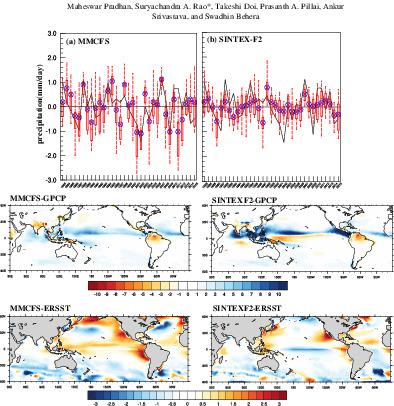当前位置:
X-MOL 学术
›
Int. J. Climatol.
›
论文详情
Our official English website, www.x-mol.net, welcomes your
feedback! (Note: you will need to create a separate account there.)
Comparison of MMCFS and SINTEX-F2 for seasonal prediction of Indian summer monsoon rainfall
International Journal of Climatology ( IF 3.5 ) Pub Date : 2021-05-02 , DOI: 10.1002/joc.7169 Maheswar Pradhan 1 , Suryachandra A. Rao 1 , Takeshi Doi 2 , Prasanth A. Pillai 1 , Ankur Srivastava 1 , Swadhin Behera 2
International Journal of Climatology ( IF 3.5 ) Pub Date : 2021-05-02 , DOI: 10.1002/joc.7169 Maheswar Pradhan 1 , Suryachandra A. Rao 1 , Takeshi Doi 2 , Prasanth A. Pillai 1 , Ankur Srivastava 1 , Swadhin Behera 2
Affiliation

|
A comparison of the Indian summer Monsoon Rainfall (ISMR) in two different coupled models (viz., Scale Interaction Experiment-Frontier-F2; SINTEX-F2, and Monsoon Mission Climate Forecast System; MMCFS) is carried out to ascertain the predictability sources in these models and their strengths and weaknesses. SINTEX-F2 has a stronger cold sea surface temperature (SST) bias in the central equatorial Pacific, and it simulates mean ISMR better while underestimating the interannual variability of ISMR. On the other hand, MMCFS has warmer SST bias in the tropical Pacific off the equator, simulates a drier mean monsoon, but has a more realistic ISMR interannual variability. Further, the cold SST bias in the central tropical Pacific adversely affects the ability of the SINTEX-F2 to capture the El Niño–Southern Oscillation (ENSO) related interannual variability and teleconnection patterns with monsoon by shifting it further westward in the tropical Pacific Ocean. The models' skill in simulating various climate indices are compared by considering criteria such as anomaly correlation coefficient (ACC), spread to root mean square error (RMSE) ratio, and signal to noise ratio (SNR). The prediction skill for ISMR in terms of ACC in MMCFS (.53) and SINTEX-F2 (.45) are comparable for hindcasts initialized in February month. However, RMSE for ISMR from February initial conditions in SINTEX-F2 (1.43 mm/day) is small compared to MMCFS (2.34 mm/day). A simple multi-model ensemble prediction system based on MMCFS and SINTEX-F2 results in better prediction skill in terms of ACC for tropical SST and ISMR. The spread/RMSE ratio for ISMR is similar in both the models but is better for ENSO indices in MMCFS at a longer lead time than in SINTEX-F2. Considering the SNR as performance criteria, MMCFS has an advantage due to better predictability of SST and vertical wind shear in several parts of the Indo-Pacific domain.
中文翻译:

MMCFS和SINTEX-F2在印度夏季风降雨季节预测中的比较
对印度夏季季风降雨 (ISMR) 在两种不同的耦合模型(即尺度相互作用实验-Frontier-F2;SINTEX-F2 和季风任务气候预报系统;MMCFS)中进行比较,以确定在这些模型及其优点和缺点。SINTEX-F2在赤道中太平洋具有更强的冷海面温度(SST)偏差,它更好地模拟了平均ISMR,同时低估了ISMR的年际变化。另一方面,MMCFS 在赤道附近的热带太平洋具有更暖的 SST 偏差,模拟更干燥的平均季风,但具有更现实的 ISMR 年际变化。更远,热带太平洋中部的冷 SST 偏差对 SINTEX-F2 捕捉厄尔尼诺 - 南方涛动 (ENSO) 相关的年际变率和与季风的遥相关模式的能力产生不利影响,因为季风将其进一步向西转移到热带太平洋。通过考虑异常相关系数 (ACC)、均方根误差 (RMSE) 比和信噪比 (SNR) 等标准,比较了模型模拟各种气候指数的能力。就 MMCFS (.53) 和 SINTEX-F2 (.45) 中的 ACC 而言,ISMR 的预测技能与 2 月份初始化的后报相当。然而,与 MMCFS(2.34 毫米/天)相比,SINTEX-F2(1.43 毫米/天)中 2 月初始条件下 ISMR 的 RMSE 较小。基于 MMCFS 和 SINTEX-F2 的简单多模式集合预测系统在热带海温和 ISMR 的 ACC 方面具有更好的预测技能。ISMR 的价差/RMSE 比率在两种模型中相似,但对于 MMCFS 中的 ENSO 指数,在比 SINTEX-F2 更长的提前期时更好。考虑到 SNR 作为性能标准,MMCFS 具有优势,因为它可以更好地预测印度洋 - 太平洋域的几个部分的 SST 和垂直风切变。
更新日期:2021-05-02
中文翻译:

MMCFS和SINTEX-F2在印度夏季风降雨季节预测中的比较
对印度夏季季风降雨 (ISMR) 在两种不同的耦合模型(即尺度相互作用实验-Frontier-F2;SINTEX-F2 和季风任务气候预报系统;MMCFS)中进行比较,以确定在这些模型及其优点和缺点。SINTEX-F2在赤道中太平洋具有更强的冷海面温度(SST)偏差,它更好地模拟了平均ISMR,同时低估了ISMR的年际变化。另一方面,MMCFS 在赤道附近的热带太平洋具有更暖的 SST 偏差,模拟更干燥的平均季风,但具有更现实的 ISMR 年际变化。更远,热带太平洋中部的冷 SST 偏差对 SINTEX-F2 捕捉厄尔尼诺 - 南方涛动 (ENSO) 相关的年际变率和与季风的遥相关模式的能力产生不利影响,因为季风将其进一步向西转移到热带太平洋。通过考虑异常相关系数 (ACC)、均方根误差 (RMSE) 比和信噪比 (SNR) 等标准,比较了模型模拟各种气候指数的能力。就 MMCFS (.53) 和 SINTEX-F2 (.45) 中的 ACC 而言,ISMR 的预测技能与 2 月份初始化的后报相当。然而,与 MMCFS(2.34 毫米/天)相比,SINTEX-F2(1.43 毫米/天)中 2 月初始条件下 ISMR 的 RMSE 较小。基于 MMCFS 和 SINTEX-F2 的简单多模式集合预测系统在热带海温和 ISMR 的 ACC 方面具有更好的预测技能。ISMR 的价差/RMSE 比率在两种模型中相似,但对于 MMCFS 中的 ENSO 指数,在比 SINTEX-F2 更长的提前期时更好。考虑到 SNR 作为性能标准,MMCFS 具有优势,因为它可以更好地预测印度洋 - 太平洋域的几个部分的 SST 和垂直风切变。











































 京公网安备 11010802027423号
京公网安备 11010802027423号